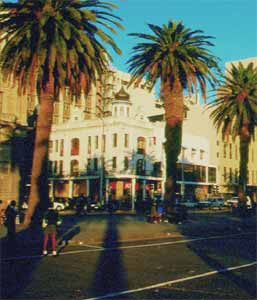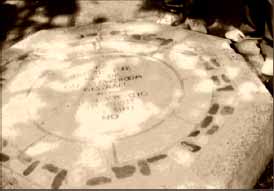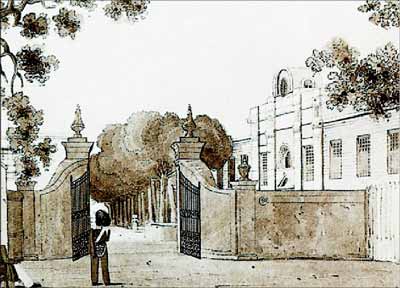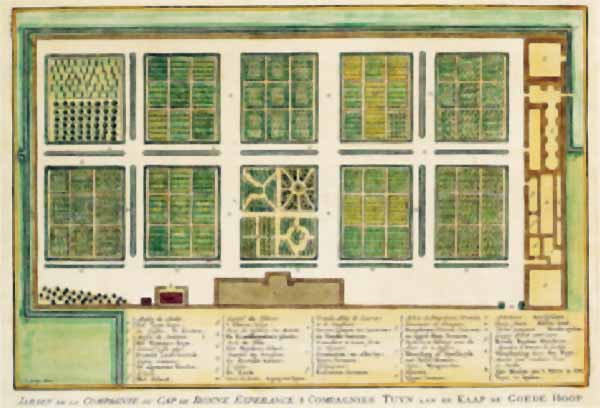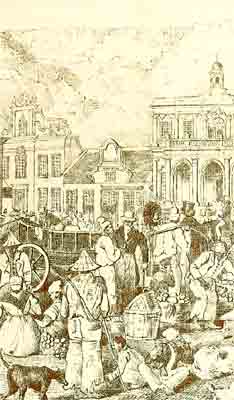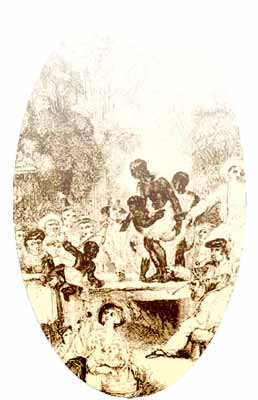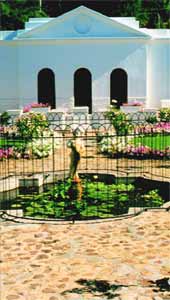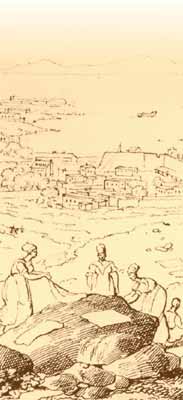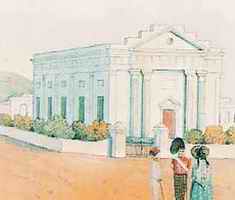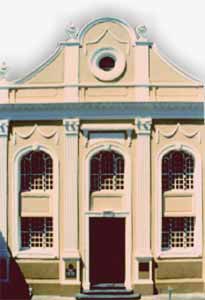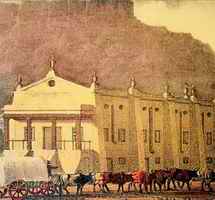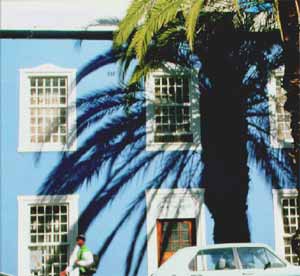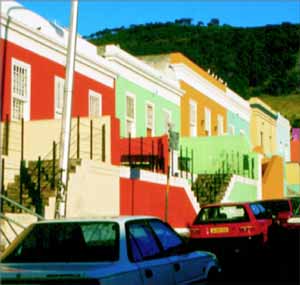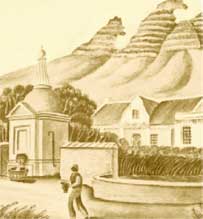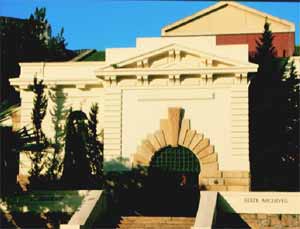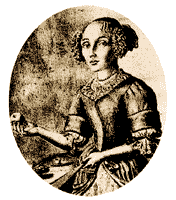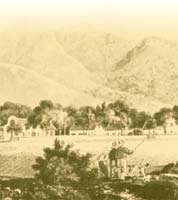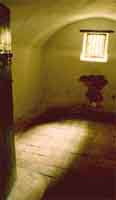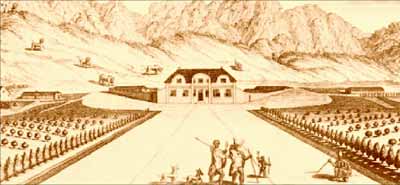Cape Town and Surrounds
(Department of Cultural Affairs & Sport, Western Cape Government)
Cape Town was built by slaves and is a slave site in its own right. This little-known fact compounds the obscurity of what remains of our slave heritage today. The city was once bursting with slaves - they were artisans, builders, coopers, bakers, cleaners, fruit and fish vendors, water carriers, grave-diggers, potters, wood collectors, gardeners and wetnurses. An estimated 63 000 slaves were imported between the mid-17th century and the early 19th century from Indonesia, India, Ceylon, Zanzibar, Madagascar, Angola and Mozambique. |
|
|||||||||||||||||||||||||
| The Parade
(Darling Street) Van Riebeeck's Fort de Goede Hoop was situated where the Parade is today. This is where slaves were first housed. |
||||||||||||||||||||||||||
|
The Slave Lodge (49 Adderley Street) In 1679 a windowless, brick structure was built to house the slaves of the Vereenigde Oost-Indische Compagnie (VOC). The building's dilapidated and filthy state was reported throughout the 18th century. Besides serving as a labour force for the Company, slaves also worked in the adjacent gardens, as well as in the hospital opposite the lodge. |
||||||||||||||||||||||||||
|
||||||||||||||||||||||||||
| The Slave Tree plaque (Spin Street) This commemorative plaque on the centre island marks the site where the Slave Tree - the place where slaves were auctioned - once stood. | ||||||||||||||||||||||||||
Justitie plaats and Whipping Post The south-western corner of Darling and Buitenkant Streets was once a place of torture and execution. There was a post to which slaves and convicted persons were tied while receiving corporal punishment. The Company's Garden One of the many gardens worked by Company slaves is at the top of Adderley Street. The others were at Rustenburg, Groote Schuur, Newlands, Fish Hoek and Simon's Town. By 1782 almost two thirds of the inhabitants of the outposts (of which the gardens formed a part) were slaves. There is a symbolic slave bell (not from this period) in the Company's Garden. Bells like this were used on farms to call slaves to work. |
||||||||||||||||||||||||||
|
||||||||||||||||||||||||||
Greenmarket Square and the Old Town House Fresh produce, such as fruit and vegetables grown in the gardens of Table Valley, as well as produce brought in by farmers from the outlying districts, were sold here by slaves earning their "coolie money" (derogatory term used for slave earnings). The slaves used a tavern next to the Old Town House for drinking and gambling. There was also a fountain on the square from which slaves fetched water.
Important notices and proclamations were read from the balcony of the Town House, including the slave code, which read:
|
||||||||||||||||||||||||||
Leeuwenhof (Hof Street) The official residence of the Premier of the Western Cape has an outbuilding dating back to the 18th century that was used as a slave lodge. Other residences in upper Table Valley also had lodges to house the slaves who worked their commercial gardens, although none of these lodges have survived. Leeuwenhof's slave lodge now houses an exhibition on the history of the estate, which is open to the public by appointment. Platteklip stream on Table Mountain This is where household slaves came to do the laundry.
|
||||||||||||||||||||||||||
|
Old Slave Church, SA Mission Museum (40 Long Street) The South African Missionary Society, an offshoot of the Dutch Reformed Church, was founded in 1799 by Reverend Vos of Tulbagh to spread Christianity to slaves. This architecturally unique church was built in 1804. Today it is a museum depicting the history of South African Christian mission work. Other mission and post-emancipation sites with slave connections are St Stephen's Church in Riebeeck Square, the church in Chapel Street and the Berlin Mission in Searle Street, District Six. Many ex-slave baptisms and marriages also took place in the Lutheran Church in Strand Street. On 1 December 1838, the day of the emancipation, a service of thanksgiving took place at St Andrew's Presbyterian Church (Somerset Road). Until the ex-slave component of the congregation moved to St Stephen's Church (then the Old Theatre) they were accommodated at St Andrew's. St Stephen's Church (Riebeeck Square) This building dates from 1801. It was originally a theatre open to all races but in 1829 slaves and free blacks were no longer allowed to attend. Ironically, this theatre was later used as a mission church for freed slaves. This caused a public outcry and the windows of the church were shattered by stone-throwing ex-theatre patrons. Because of this, the church was named after the martyr St Stephen, who was stoned to death. It is unusual in the Dutch Reformed Church to name a parish after a martyr. |
||||||||||||||||||||||||||
|
||||||||||||||||||||||||||
Auwal Mosque (39 Dorp Street) The Muslim faith was brought to South Africa by slaves imported from the East. This mosque's history dates back to 1794. The property was owned by a freed slave, Salie Coridon of Ceylon. His daughter married Achmat of Bengal, who later inherited the property and subsequently made it available to the Muslim community to be used as a mosque. It is the oldest mosque in the country. Palm Tree Mosque (Long Street) It was built in the 1780s as a house with a prayer room upstairs and the Imam's residence downstairs. The Muslim congregation of the Palm Tree Mosque has an oral tradition which says that the house was given as a mosque to the Imam by his son-in-law, Jan Boekies. Unmarked graves (Somerset Road, Green Point) Slaves and paupers were buried in an unmarked burial ground at the lower end of Signal Hill (where the Green Point Traffic Department is today), as well as in the Coburn Street area. Bo-Kaap and Tana Baru cemetery The Bo-Kaap is inhabited mainly by descendants of slaves who were brought here by the VOC in the early days of the settlement. This area is characterised by narrow, cobblestone streets and mosques. Many of the flat-roofed houses date back to the 18th century. The Bo-Kaap Museum (71 Wale Street) is furnished as a 19th century Muslim home. Many slaves were Muslim and were buried above the Bo-Kaap. The burial ground has a magnificent view of the city.Tel: 021 481 39393 Hurling Swinging Pump (Prins Street) There was no piped water in Cape Town and slaves were sent to fetch water from public fountains or wells like this one. |
||||||||||||||||||||||||||
|
||||||||||||||||||||||||||
Cape Town Archives Repository (72 Roeland Street), Deeds Office (90 Plein Street) and the Dutch Reformed Church Archives (top of Queen Victoria Street) contain a wealth of archival material relating to slavery at the Cape, as well as genealogical information on slave ancestry. National Library of South Africa (Company's Garden),
|
||||||||||||||||||||||||||
| Groot Constantia (Constantia Road, Constantia) The farm Constantia was granted to Governor Simon van der Stel in 1685. In 1692 he built a U-shaped house on the property.
Constantia wines were well-known in the 18th century and competed with Madeira wine in Europe. Lady Ann Barnard watched wine being made here in 1798 by slaves "who were dancing in the wine press and beating the drum" and the slaves danced on them softly, the wine running out from a hole at the bottom of the barrel, this was done to slow music...". At Groot Constantia a few of the slaves were musicians. Today the house and outbuildings function as a museum containing furniture and porcelain from the VOC period. Slaves were housed in a building next to the Jonkershuis (a separate building near the main house). Anna de Koning, the daughter of a freed slave, inherited Groot Constantia from her husband, Oloff Bergh. She owned 27 slaves. Tel: 021 795 5140 |
||||||||||||||||||||||||||
| Old Residency, Simon's Town Museum (Court Road) The museum has close connections with a few of the local families in the area who have done genealogical research on their slave ancestors, many of whom were Muslims. Some families have kitaabs or diaries going back to slave times. In the basement of the former Residency there are cells where criminals and slaves were imprisoned. There is also a Muslim Heritage Museum in King George Way. Tel: 021 786 3046 or 021 786 2303 |
||||||||||||||||||||||||||
|
||||||||||||||||||||||||||
Vergelegen (Lourensford Road, Somerset West) This is a working wine estate with an old house, outbuildings and a slave lodge. In about 1700 Willem Adriaan van der Stel erected an outbuilding that resembled a 17th century European hallehuis - a large three-aisled barn-like structure with a thatched roof reaching almost to the ground. The slave lodge housed up to 200 slaves at a time. The slaves at Vergelegen worked as cabinet-makers, tailors, cooks, masons and labourers. The lodge was excavated for the Anglo-American De Beers Chairman's Educational Trust in 1989. The remains of a slave woman were discovered under the floor of the site. She was re-buried on the farm in a marked grave, which can be visited. There is an interpretive centre on the farm where artefacts recovered during archaeological excavation are displayed.
|
||||||||||||||||||||||||||

